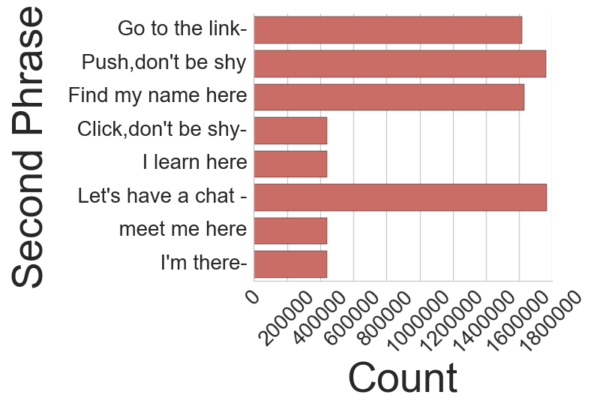US Banks Targeted with Trickbot Trojan
The Necurs botnet has begun delivering the Trickbot banking Trojan to financial institutions in the United States, a sign of increasingly larger and more complex attacks on the industry.
Trickbot, which specifically threatens businesses in the financial sector, has been behind man-in-the-browser (MitB) attacks since 2016. Until now, its webinject configuration was only used to hit organizations outside the US.
Researchers at Flashpoint discovered a new Trickbot spam campaign, called “mac1” on July 17. The latest iteration is fueled by the Necurs botnet and was developed to hit 50 additional banks including 13 companies based in the US. Necurs, one of the largest spamming botnets in the world, emerged in 2012 and has since become known for propagating spam campaigns.
“It sends a massive amount of spam email, one of which is recently starting to spread Trickbot,” says Flashpoint malware researcher Paul Burbage, who has been monitoring Necurs for the past couple of years.
Mac1 has an expanded webinject configuration, which it uses to hit customers of financial institutions both in the US and abroad. Other victim countries include the UK, New Zealand, France, Australia, Norway, Sweden, Iceland, Canada, Finland, Spain, Italy, Luxembourg, Switzerland, Singapore, Belgium, and Denmark.
So far, Mac1 has driven at least three different spam waves, Flashpoint reports. The first contained an HTML email disguised as a bill from an Australian telecommunications company. These contained a Zip-archived Windows Script File attachment with obfuscated JavaScript code. When clicked, the files download and execute the Trickbot loader.
One of the main concerns with Trickbot is account takeover and fraud, which may increase among US financial institutions as the malware spreads. Burbage says the main significance of Mac1 is how far and wide it’s being spread.
While its primary focus is financial institutions, experts anticipate other companies will eventually be at risk.
“We think it’s capable of developing new features in the future,” says Flashpoint senior intelligence analyst Vitali Kremez. “For now, it’s a banking Trojan with potential to move beyond that.”
The latest iteration of Trickbot, and its spread to the United States, indicate its authors’ sophistication, Kremez continues. Flashpoint believes a Russian-speaking gang is behind the malware.
“I’ve been constantly amazed by the sophistication and resourcefulness of the Trickbot gang,” he says, noting Necurs is only used among advanced actors. “They constantly develop means to proliferate the malware and bypass spam filters … they also have the infrastructure to proliferate the malware at scale.”
Trickbot is considered the successor to the Dyre banking Trojan, says Kremez, citing similarities between their infrastructure and setup of their configuration files. It’s possible the Trickbot author was either deeply familiar with Dyre or reused old source code. The threat actors behind Dyre have historically targeted Western financial institutions in the US, UK, and Canada.
Burbage and Kremez anticipate Trickbot will continue to evolve and target financial customers both in the US and around the world.
Trickbot’s expansion isn’t the only sign pointing to more dangerous banking Trojans. Fidelis Cybersecurity today released findings on its analysis of the Emotet loader, which was initially used for credential theft but is now used to deliver banking Trojans.
Emotet is an active threat using mass email spam campaigns to deliver malware. Fidelis found Emotet uses spam for propagation using basic social engineering techniques. Some samples have internal network propagation components, or spreaders, built in – a new strategy for banking malware authors that hasn’t been seen much in recent years.
Early banking Trojans were crude and built to work against as many targets as possible, says John Bambenek, threat systems manager at Fidelis Cybersecurity. Emotet and others now use injects to customize the threat to specific banks’ look and feel, he explains.
“An entire ecosystem has developed around this type of malware involving exploit writers, malware delivery systems, inject writers, money mules, and underground criminal marketplaces” like Alphabay, Bambenek says.
Fidelis reports it’s not surprising to see cybercriminals include spreaders in their campaigns after widespread attacks WannaCry and Petya demonstrated their effectiveness in driving infections across enterprises. More malware authors are adding functionality based on attacks in the news, which could indicate a trend we’ll see more of in the future.
 Black Hat USA returns to the fabulous Mandalay Bay in Las Vegas, Nevada, July 22-27, 2017. Click for information on the conference schedule and to register.
Black Hat USA returns to the fabulous Mandalay Bay in Las Vegas, Nevada, July 22-27, 2017. Click for information on the conference schedule and to register.
Related Content:
- BEC Attacks Far More Lucrative than Ransomware over Past 3 Years
- Online Courses Projected to Drive Credit Card Fraud to $24B by 2018
- 98% of Companies Favor Integrating Security with DevOps
- Best of Black Hat: 20 Epic Talks in 20 Years
Kelly Sheridan is Associate Editor at Dark Reading. She started her career in business tech journalism at Insurance Technology and most recently reported for InformationWeek, where she covered Microsoft and business IT. Sheridan earned her BA at Villanova University. View Full Bio
Article source: https://www.darkreading.com/attacks-breaches/us-banks-targeted-with-trickbot-trojan/d/d-id/1329417?_mc=rss_x_drr_edt_aud_dr_x_x-rss-simple
 Black Hat USA returns to the fabulous Mandalay Bay in Las Vegas, Nevada, July 22-27, 2017. Click for information on the
Black Hat USA returns to the fabulous Mandalay Bay in Las Vegas, Nevada, July 22-27, 2017. Click for information on the 




 Black Hat USA returns to the fabulous Mandalay Bay in Las Vegas, Nevada, July 22-27, 2017. Click for information on the
Black Hat USA returns to the fabulous Mandalay Bay in Las Vegas, Nevada, July 22-27, 2017. Click for information on the